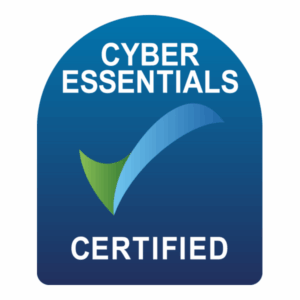Phishing doesn’t rely on technical skills or complex hacking; instead, it relies on the trust of people.
You might receive an email that appears to come from your bank, your IT provider, or even your managing director.
These messages will look very convincing; even the logo and the tone will feel familiar, but they can be very difficult to spot. Usually, they will ask you to click on a link or to confirm details. Once this happens, credentials are stolen, and your business is then at risk.

That’s phishing in cybersecurity. It’s a form of social engineering that is designed to exploit human behaviour rather than exploiting technology.
To protect your company, you need to make sure that you understand how phishing works, what types of attacks you need to keep an eye out for, and how you can build up habits that are going to make your people as strong as any firewalls you have.
Phishing in cybersecurity refers to when people are deceived into revealing confidential information. These might be things like banking details, passwords, or even login credentials. The messages are made to look completely legitimate, and they will usually use the names and branding of very trusted companies.
The tactic is very simple, but it’s extremely effective. Attackers imitate real communications, and they are very convincing. They convince people to share data voluntarily or to click on links that lead to fake websites. Once the people are there, the information is harvested or malware is installed silently in the background without them even knowing.
This method works extremely well because it targets people rather than software. Attackers take full advantage of routine habits, such as the tendency to try and respond quickly to messages. They trust that people have familiar logos or comply with requests that appear to be from authority figures.
Phishing emails can be carefully tailored to individuals, too. Attackers often research their targets using public information, company websites, and even social media. They use this knowledge to craft believable stories. A message, for example, might reference a real supplier that a business uses, use your manager’s name, or even copy your internal communication style.
Understanding this kind of tactic is the key to making sure that businesses have the right protection. It is a reminder that good cybersecurity isn’t all about technology, and technology isn’t solely to be relied on. It’s also about being fully aware and being cautious.
Phishing takes many different forms, and attackers are constantly finding new ways to disguise their intentions. It’s important that businesses are aware of the main types, as this can help their teams to recognise them quickly.
This is the classic and the most common method that is used. Attackers will usually send mass emails pretending to be from a trusted source, usually a bank, delivery company, or even a popular online service. The message usually includes a link or attachment which asks people to verify an account or confirm a payment.
The language often creates pressure, such as saying your account will be suspended unless you act now. This urgency is designed to override your caution and make you act without thinking about it properly.
Spear phishing is more targeted and far more convincing. Attackers will research a certain person, or people, or department, and they will tailor the emails with extremely accurate details. They might know your suppliers, names, project titles, or even the names of your colleagues.
Imagine your finance manager receiving an email from what appears to be a well-known supplier that you have used for many years, referencing a real invoice number. It looks genuine, but it redirects payments to a fraudulent account. Because it feels relevant and familiar, the message bypasses any suspicion that your finance manager actually has.
Whaling target senior executives or directors of a business, usually referred to as the Big Fish. These individuals often approve large transactions or are in charge of handling sensitive data. A wailing email might look like a legal request for an internal financial report. The tone is professional and very direct; it’s designed to trigger quick action.
Phishing doesn’t always happen by email. Smishing uses text messages, while vishing uses voice calls. You might get a text claiming to be from your bank asking you to confirm a payment, or you might get a call pretending to be somebody from the IT support department.
These attacks work because they feel like they need immediate attention. People are more likely to trust a voice or react quickly to a text message, especially if the message suggests that something is urgent or time-sensitive.
Clone phishing involves copying a legitimate email that you have received before and replacing a legitimate link that was contained in it with a malicious one. Because the design looks identical to something familiar that you have seen before, it usually escapes any suspicion.
One of the most financially damaging forms of phishing cybersecurity is business email compromise, or BEC, as it is usually referred to in these types of cases. Attackers either gain control of a real business email account or create a perfect imitation of it. They then work by sending messages requesting urgent payments or requesting sensitive data, often impersonating a senior executive.
Because the message appears to come from somebody who has authority in the business, employees may act before they even decide to verify the details. This single mistake can cost a business thousands of pounds.
Phishing techniques constantly evolve, but they all heavily depend on one thing: trust from the people they target. Recognising how that trust is exploited allows you to stop and attack before it even begins.
Phishing might start with one message, but its effect can be extremely widespread and long-lasting, even permanently damaging for some businesses.
The most obvious consequence is financial loss; attackers may steal funds directly from a business, divert payments, or sell stolen credentials. But going past money, phishing can cause serious operational and reputational damage that sometimes cannot be recovered.
When confidential data is exposed, your business can face regulatory consequences under UK data protection laws, including the GDPR. There can be heavy fines for data breaches, and they can be extremely damaging for a business. But the loss of client confidence can cost a business even more.
Operational disruption is another major risk for businesses. Investigating an attack can require systems to be taken offline, meaning that you have a lot of downtime. This can impact productivity as well as customer service. In some cases, attackers use phishing as an entry point for ransomware, which locks you out of your own data until a payment is made.
For some smaller businesses, a single phishing incident might be enough to cause lasting harm that causes them to close their doors. Recovering from a breach takes a lot of time, money, and trust, all of which are easier to preserve than to rebuild. Understanding this impact reinforces why phishing must be treated as a business-wide issue and not just something for the IT Department.
There is no way to completely eliminate phishing and its threats, but you can make it much less likely that it is going to succeed in your business. Prevention depends on combining policies, technologies, and culture.
You should start off by making sure that you have a strong email security system and that your employees all understand the rules they need to follow. Advanced filtering tools can analyse incoming messages and block suspicious content before it even reaches your staff. These systems detect known phishing domains, fake sender addresses, and dangerous attachments, which reduces the chance of it ever landing in their email account. If it does ever make its way to your staff, you need to make sure they are trained to be able to identify phishing emails and understand never to click on any suspicious links.
Multifactor authentication (MFA) is another simple but powerful defence businesses should be using. Even if an attacker steals a password, they can’t access the account without having the second layer of verification. This is usually something like a code sent to a device or an authentication app.
Keeping your software and systems up to date is just as important. Many phishing campaigns attempt to install malware or exploit old vulnerabilities, so if you have an out-of-date system, it might be time to upgrade it. Regular updates close those gaps before attackers can make use of them.
Policies should reinforce these technical measures too. Make sure you have a clear set of rules for verifying sensitive requests, such as bank transfers or data access. If an email asks for something unusual, staff should confirm it through another method, ideally by phone or in person. You could, for example, have a protocol where people have to confirm a transaction that’s over a certain amount with somebody by phone before they continue.
Finally, investing in regular training on cybersecurity and phishing prevention depends on people understanding what they need to look out for. Short, consistent sessions are far more effective than having occasional long workshops. This stops you from missing any new employees from starting, and it also means that it is always fresh in people’s minds. Real examples of phishing emails your business has received can make training more practical and memorable, and show people the types of things they need to be looking out for.
You could even run internal phishing simulations or tests. These are harmless little tests to show your staff how to respond in real-time and highlight where additional support might be needed.
When you have the right layers of defence in place and consistent awareness across your teams, phishing attacks lose a lot of their power.
Recognizing a phishing email does take a little bit of training; however, once that training has been started within a workplace, it becomes more second nature, especially when your staff know what to look out for.
The first thing that they need to look out for is the sender’s address, as attackers often use ones that look almost right, but they will have a little bit of a variation. Make sure your staff are always checking the full email address, not just the name that appears in the sent box.
The way that an email is written is also a huge clue. These types of emails will usually sound a little bit off from what you would usually receive; the tone might be different, or it may even contain grammatical errors.
Links and attachments are the most dangerous elements in a phishing email. Hover over links before clicking on them so that you can see the true destination. If it looks suspicious or unfamiliar, just don’t open it. Only download attachments from trusted sources, and even then, you should confirm that the sender actually meant to send them.
Branding is worth inspecting, too. Many phishing emails copy company logos, but they don’t quite get the colours or fonts slightly right.
Technology is essential, but awareness is what is going to make protection for your business effective. A well-informed team is the best place to start, and it’s the strongest defence that you have. When people understand the risks and know what warning signs to look out for, they are much less likely to fall for deceptive messages or emails. Building this type of awareness all starts with the leadership. If management takes phishing seriously and then communicates that openly to their teams, the message will spread across the organisation.
Awareness also goes beyond the workplace. Remote and hybrid working environments have a bit of a blur when it comes to personal and professional accounts. Teaching staff to apply the same caution at home helps to reduce the risk even further for businesses, as well as phishing threats and distractions. So, make sure you are encouraging curiosity, carefulness, and open communication with your teams.
Phishing is still one of the most persistent and successful types of cyber attack, and it can be awful for businesses of any size.
It targets people rather than systems, so it relies heavily on trust, familiarity, and haste. This is also how you can protect your business, especially when you provide your teams with the right training.
Understanding what phishing is, recognising its many forms, and building habits that prioritise things like verification and caution, your business should be able to stay ahead of these types of scams.





